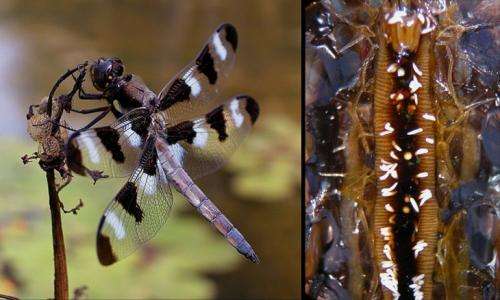Dragonfly gut infections suggest environmental role in obesity

Obesity and diabetes are not just problems of modern-day humans and their domesticated pets. Insects also are affected by these health conditions, and intestinal infections by protozoans are the cause, according to researchers at Penn State. The research suggests that intestinal infections may contribute to metabolic diseases, including diabetes and obesity, in humans as well.
Ruud Schilder, assistant professor of entomology and biology at Penn State, has received a three-year grant from the National Science Foundation to expand upon these findings, which he and his colleague Jim Marden, professor of biology at Penn State, have made in recent years.
Schilder will examine whether the environmental conditions in which dragonflies (Libellula pulchella) live make them susceptible to infectious protozoan parasites, and how infection by protozoans affects dragonflies' flight performance and fuel use. He also will investigate whether protozoans manipulate the behavior and physiology of dragonflies, or whether the metabolic disease symptoms are simply part of dragonflies' response to infection.
"Obesity is occurring at very high rates in humans and other mammals," said Schilder, who holds faculty appointments in the College of Agricultural Sciences and Eberly College of Science. "A recent meta-analysis of body composition in a whole suite of lab-reared and 'urbanized' mammals—such as primates, cats and dogs—shows increased rates of obesity, even in the absence of dietary changes. This clearly suggests that factors other than diet and exercise are important."
Schilder noted that an infectious origin of obesity has been suggested for several species of vertebrates and is now an emerging field of research, known as "infectobesity." Yet, other than Schilder's work in this area, this phenomenon has not been examined in invertebrates.
"Our preliminary data indicate that infected dragonflies display a very similar shift in the composition of their gut microbiome [the collection of microorganisms in the gut] to that which has been linked to the development of obesity in humans and other mammals," he said. "It suggests that the occurrence of metabolic disease may be widespread in nature.
"I think our work makes a pretty good case for the need for a comparative approach to studying infectious origin of metabolic diseases that includes nonmodel and naturally occurring invertebrate systems."
Schilder plans to test the hypothesis that susceptibility to gut infection is associated with variation in gut microbe composition caused by the pH of the water in and around which dragonflies live. To do this, he will test the effects on healthy dragonflies, both larvae and adults, of acute and chronic exposure to water of varying pH levels and amounts of infectious protozoan spores.
Schilder has found that the more acidic the water—which could be influenced by factors such as soil type and the presence of fertilizers—the greater the percentage of dragonflies infected with protozoans.
At the end of the pH treatment, Schilder and Emily Hornett, Marie Curie Fellow at Penn State, will assess the degree of infection in the dragonflies, as well as the composition of their gut microbiomes.
In addition, Schilder will examine how gut infection affects flight performance and fuel use during endurance flights using high-speed videography and respirometry, which measures oxygen consumed and carbon dioxide produced during activity. He also will examine how chemical interactions between the dragonfly and the protozoan affect the activity of dragonfly enzymes responsible for the creation and oxidation of muscle fat.
"Dragonflies do not show their obesity from the outside," Schilder said. "They have exoskeletons that cannot expand much, so rather than showing a belly, they tend to just pack more fat more tightly in between their muscles." The inability of muscles to use the fat can adversely affect flight performance, he added.
Finally, Schilder will examine whether the protozoan parasites are manipulating the behavior and physiology of dragonflies or whether the metabolic disease symptoms are simply part of dragonflies' response to infection. He explained that healthy dragonflies may exhibit a physiological trade-off between mating and immunity, wherein they can either spend more energy on reproductive behaviors or on fighting disease. Parasites may manipulate the action of certain hormones within their host to control this trade-off.
"Given that we and our microbes don't live in isolation from the environment, I believe that our research in a natural system that displays metabolic disease is very important," said Schilder. "Determining what environmental factors cause disease in some natural populations, and may protect against disease in others, ultimately may yield important insights that could help prevent or treat related human diseases."
Provided by Pennsylvania State University

















